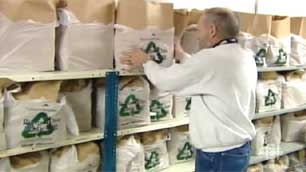Canadian Northern Food Bank Use Rises Sharply
 Food bank use in Canada’s northern territories jumped by 59 per cent this year, creating challenges for food banks in the region.
Food bank use in Canada’s northern territories jumped by 59 per cent this year, creating challenges for food banks in the region.
The latest statistic comes from Food Banks Canada’s HungerCount 2010 survey, which found food bank use across Canada had gone up by 9.2 per cent between March 2009 and March 2010.
The national survey, released this week, found that the northern territories had the biggest increase in the country, with food bank use across the region going up by 59 per cent, or 843 people.
Staff at food banks in Iqaluit, Yellowknife and Whitehorse say they have noticed an increase in the number of people they are helping.
“When we opened our doors in 2000, we had a client base of 25 people. Now at last count, in 2009, we served over 1,200, almost 1,300 people,” Jen Hayward, a volunteer at the Iqaluit Food Bank, told CBC News.
Trying to keep up
Food banks in Yellowknife and Whitehorse are also reporting increases, and staff say they cannot always keep up with the growing demand.
“We’ve had to limit the amount that we give out,” said Dave Ritchie of the Yellowknife Food Bank.
“We limit it to 150 bags on a Saturday. After we give out 150 bags, then we have to close the door and turn people away.”
In Whitehorse, where a new food bank opened in April 2009, officials say they are seeing 125 clients each week, compared to about 75 to 80 clients a week around this time last year.
“There is a higher need out there,” said Stephen Dunbar-Edge, the Whitehorse Food Bank’s executive director.
“I think that a lot of people are just not able to make ends meet. I think that we do have an underemployed situation.”
More people to feed
In Iqaluit, Hayward said the annual sealift order that would keep the food bank going for 10 to 12 months would now last about eight months.
Jen Hayward of the Iqaluit Food Bank says clients come from a wide range of backgrounds. (CBC) “We have one client that may come in and say, ‘I’ve got five people in my family but my brother and his four children are living with me,’ so we’re noticing an increase in family size,” she said.
The HungerCount 2010 survey also indicates that 94.5 per cent of food bank users in the territories this year identified themselves as aboriginal — way above the 12.1 per cent average across Canada.
Hayward said people using food banks come from a wide range of backgrounds, not just those who are unemployed and homeless.
“The person sitting in the cubicle next to you may be a user of our services,” she said.
In Yellowknife, Ritchie said while a small per cent of people may be abusing food bank services, the majority of clients face a real need.
“We know there’s some abuse, we think maybe it’s 10 or 15 percent, but obviously we still have 85 or 90 per cent of the people here that have a genuine need,” he said.
Food Banks Canada, which puts together the annual HungerCount survey, is calling on the federal government to implement a national poverty prevention and reduction strategy, as well as a nationwide housing strategy.
As well, it is urging Ottawa to maintain current levels of federal transfer payments to provincial, territorial and First Nations governments.



